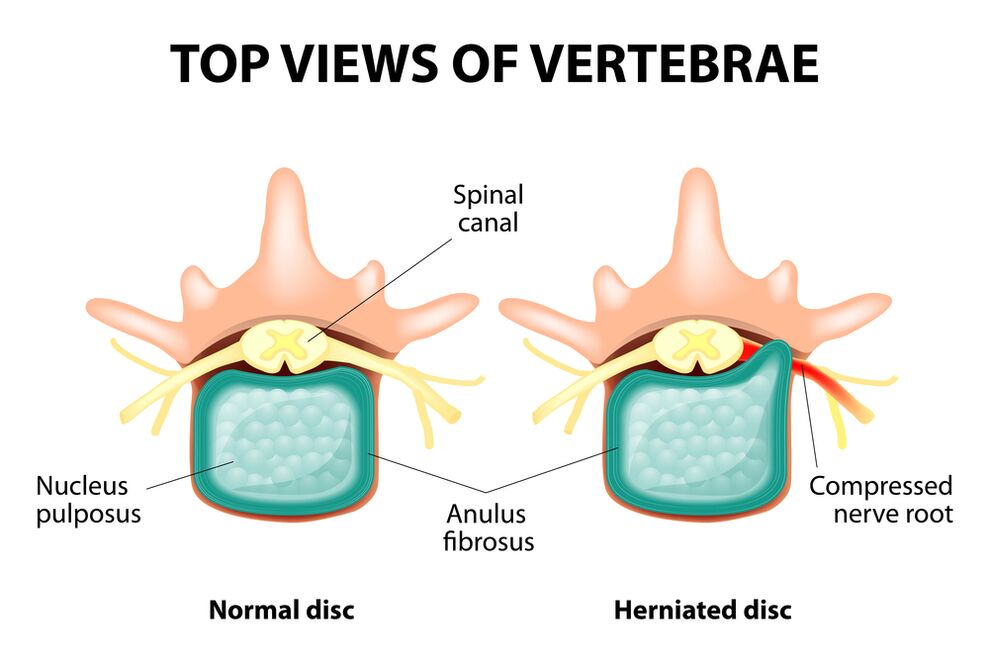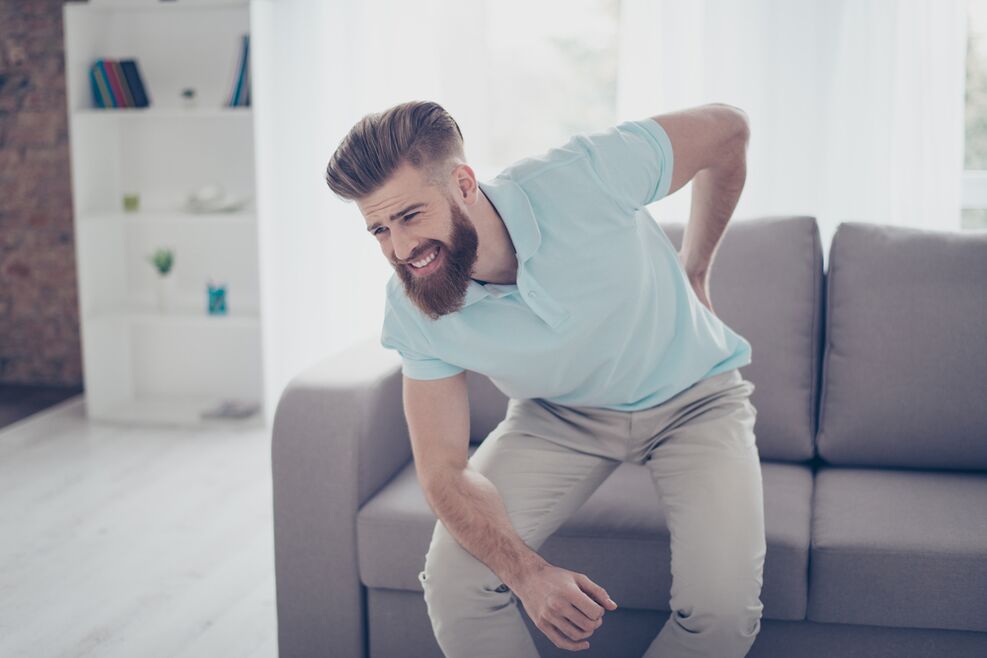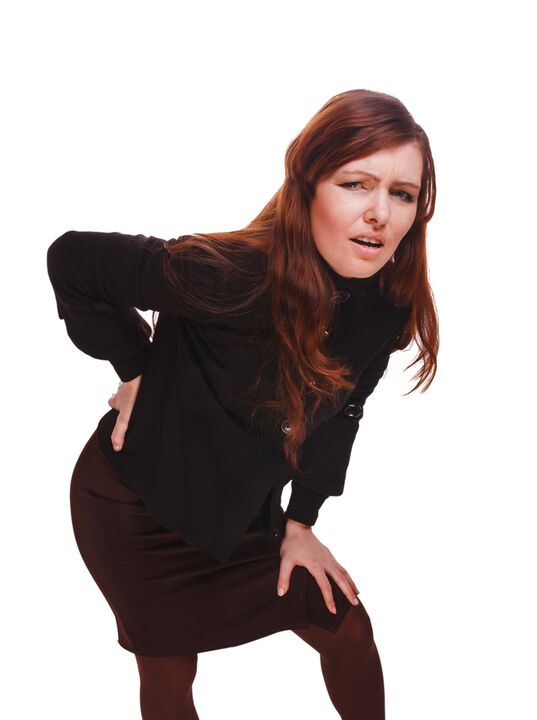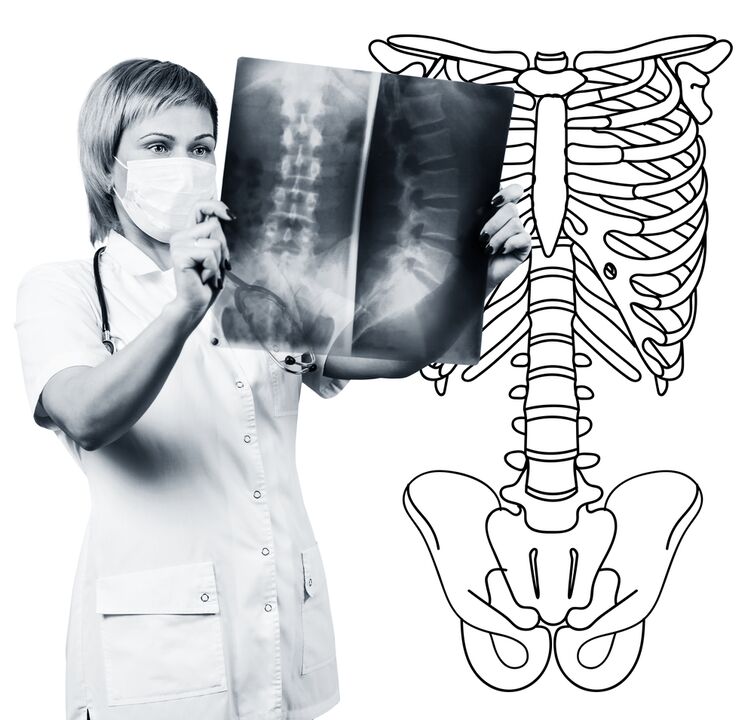
Osteochondrosis of the waist area is a chronic degenerative disease of lumbar spine affecting the structure of intervertebral discs and some lumbar vertebrae.It affects people at age mainly working.It manifests in different symptoms, is the back and lower leg pain, limiting the movements on the lower back.For diagnosis, research methods such as X -ray, calculation layer cut or magnetic resonance imaging of the lumbar spine are used.In this article, you can be more detailed with the causes, symptoms and diagnosis of the lumbar osteoarthritis.
Osteochondrosis is the result of the aging of the body.These signs or other signs of this disease can be found in most people (!), Starting at the age of 25.But this is the severity of these changes, their progress rate, the level of clinical manifestations depends on many causes, mainly on a healthy lifestyle leading to a specific person.Moderate physical activity, mandatory morning gymnastics, proper posture of the body when performing a number of jobs (garden, construction, cleaning of the house, etc.), orthopedic mattresses are moments that prevent the development of osteoarthritis.
According to statistics, osteoarthritis of the spine in 80% of cases is the cause of back pain.

How to develop osteoarthritis?
The entire spine consists of separate vertebrae, between the body with a disc.That is, between two vertebrae is a plate.The disc includes a gelatin nucleus (pulp) and yarn ring.The core contains a lot of water and provides depreciation and flexibility of the spine.The fibers are placed along the peripheral of the jacket nucleus, as if holding it in itself.
With prolonged increase in the wharf core, it changes its physiological properties, dehydration and dryness, and finally the string: the disk is flattened, and the vertebrae are close together.Along with such processes, in the nuclear jacket, the fibers lose its elasticity and, under the influence of mechanical loads, begins to protrude.This is called protruding.After that, the fibrous circles, and a gelatin nucleus fall through the gaps: a hernia of the plate occurs.A conspiracy of two adjacent vertebrae and a plate between them, called the vertebrae segment, has the ability to move excess, thus increasing the load on nearby segments.The overload of adjacent segments activates a similar pathological process in it.These changes are called bones and joints.
For somehow to ensure the stability of the spine, the growth of the bone is formed along the edges of the vertebrae, increasing the support area.This phenomenon is called spinal disease.Changes in joints between vertebrae are called Arthrosis Spondylo.Usually all three pathologies - osteoarthritis, spinal disease, spinal arthritis - walk nearby.
Reason
Why does bones and joints happen?So far, there are some theories about the appearance:
- Mechanical theory: Perhaps the main reason should be considered a regular load on the spine.That is why bones and joints are an almost compulsory fate of the driving force, miners, builders and people of such industries.The appearance of osteoarthritis of the waist area is mainly related to slopes and increases the severity, forcing an uncomfortable job position;
- Another factor in development is inaccurate posture, sitting in a wrong position, especially suitable for mental workers;
- Sometimes the role is closed by the genetic characteristics of the structure of the spine and the nutrition of its individual structures;
- Injury theory: Any injury to the spine (even the most significant people) can launch a degenerative process;
- Hormonal metabolism disorders and endocrine diseases may adversely affect the metabolism in the tissue of the spine and contribute to the development of osteoarthritis;
- The theory of age implies the natural wear and tear of disks during the life.
Rarely, only one of these theories can explain the appearance of osteoarthritis in each case.More often at the same time, some factors are people who can blame.
In the appearance of osteoarthritis of the lumbar spine, overweight plays an important role, because it is overloaded for the spine.The higher the body mass index (the level of obesity), the more significant changes in the spine are usually.Among other reasons the appearance of osteoarthritis, one can note:
- Sedentary lifestyle;
- Imorly nutrition (fast, sweet food, semi -complete products: All of this leads to the imbalance of micro -factors) and lack of liquid;
- The abnormalities of the structure of the spine (for example, the presence of an additional lumbar vertebra);
- Wearing high shoes is not continuous;
- Pregnancy (due to residual load in the lumbar spine);
- Sudden training ending in professional participants in sports;
- Smoking and alcohol abuse: is a factor to accelerate the aging process in the body.
Symptom
The main manifestation of osteoarthritis of the lumbar spine is pain.The nature of the pain, the place of occurrence and the distribution direction depends on the excited receptors, which means that the rough change in the disc and surrounding tissues, with protruding or hernia, in the direction of protruding formed and so on.
Reflection and compression syndrome are distinguished from osteoarthritis of the lumbar spine.
The reflection syndrome develops in the case of the receptors of the disk's fibers, ligaments and joint capsules are stimulated nearby.They are reflexes because in addition to the pain associated with muscle, plants or neurological changes, which is stimulating with reflections that are transmitted to other structures, causing symptoms mainly from soft tissues.
The compression syndrome is the result of compression (compression) of nerve roots, blood vessels or spinal cord formed by osteoarthritis due to change.

Reflection syndrome of the lumbar spine
Lumbago.It is believed that the appearance of belts is associated with the movement of a nucleus in the yarn, meaning it develops in the early stages of osteoarthritis.Often the pain is described as "feeling", "shares are trapped on the lower back".Patients froze in a posture in which the pain of catching them.The smallest move causes an increase in pain (sneezing, coughing, trying to turn in bed, moving your feet).If a person is in a leaning position at the time of developing Lumbago (most often), then he cannot stand up straight.A distinct muscle voltage in the lumbar spine occurs by reflexes.Along the vertebrae in this area, a mechanical roller is perceived, sometimes visible to the naked eye does not touch, and the muscle tension is very clear.Feeling pain for the patient.Such a muscle tone increases such a fixed role, protecting the belt segment affected from pathological movement, which can cause a decline in the state.The natural bend of the spine column on the lower back (Lordosis) is flattened, perhaps the curvature (scoliosis) may be due to muscle tension.
Lumbalgia- Another reflected syndrome of the lumbar level.This term also means the presence of pain in the lumbar region.But, unlike Lumbago, the pain did not arise deeply, but gradually, within hours or even a few days.The pain is stupid, moderate intensity, enhanced in movements, in sitting or standing, when moving from one position to another.A little relief gives a position down or back with a roller under the lower back, but the passive increase of legs in this position causes pain in the lower back (Lassa symptoms).The touch of the lumbar spine is painful, but the strain of the muscles is less pronounced than the waist, and sometimes absent.Movement in the lumbar spine is limited, but maybe.This means that the patient may bend down and on both sides to a certain extent (and then the increased pain).
Sciatica- A series of other reflective syndrome at the lumbar level.This term means pain in the lower back, to the buttocks and legs (on the rear surface).The pain is different, mostly painful, but may be periodically enhanced by the type of fireplace on the foot.Just like with Lumbalgia, it enhances it with any movement, walking, stress, and decrease in the back.Lassa symptoms are often positive.The touch of the lumbar spine is painful, as well as clicking some points (for example, in the middle of the lines separating the buttocks with the thigh, in the middle of the back of the thigh, in the middle of the Fossa Pooleal).There is the tension of the lower back muscles.The leaning forward and the faces are limited.

Compression syndrome of lumbar spine
Clinical characteristics depend on which structure is compressed.
Between the vertebrae in each intervertence hole is the nerve root (spinal nerve): left and right.If the formation of disease for osteoarthritis of the lumbar spine (mainly the disc of the disc) tightens the roots, the radio disease develops, the symptoms are different for each root.Proposal to all radioactive diseases of the lumbar region is an increase in pain in the process of sneezing, coughing, movement on the lower back (especially leaning forward), the presence of muscle tension on the lower back, limiting motion in the lumbar spine.The following types of radioactive diseases of the lumbar spine are the most common:
- Radiculopathy L1, L2, L3: Pain occurs on the lower back, for the thigh to predict.In the same area, the appearance of abnormalities (a sense of goosebumps, paralysis) is possible, the surface sensitivity is disturbed (an acute communication with usual is not distinguished, the feeling of cold and hot) is lost.The knee reflexes decreased, the weakness of the quadriceps of the thighs was revealed;
- Radiculopathy L4: Pain from the lower back gives the front of the thigh, the inner surface of the knee joint and slightly lower along the inside of the lower leg.In the same area, the perception is perceived and the surface sensitivity is lost (decreasing).Weaknesses in the quarter muscle of the thigh also developed, the knee reflexes decreased;
- Radiculopathy L5: one of the localities regularly.The pain for the buttocks, along the outer edge of the thigh, along the front surface of the lower leg to the inner edge of the feet and thumb.The perception is felt here, the superficial sensitivity is disturbed, and a pain given here when sneezing and coughing.In addition, there is a difficulty in expanding the thumb of the feet, because the muscles perform this action congenital by Kine L5.Sometimes it is difficult to stand on a heel with a feet exposed;
- S1 radioactive disease is also often found with osteoarthritis of the lumbar spine.The pain for the buttocks, along the outer edge of the thigh, along the outer edge of the lower leg to the outer edge of the fifth feet and fingers, heels.These areas are characterized by an intense feeling, reducing surface sensitivity.Achilles reflexes are reduced.With this spine damage, the weakness of the muscles of the lower legs and the bend of the foot developed, so standing and walking on all socks is difficult.
The simultaneous development of radioactive disease of some roots is possible, this is especially characteristic of L5, S1.It occurs that a hernia tightens some roots.
If the fish is stamped, it can squeeze the spinal cord.This can only be when the hernia is located at the reference point above, because there is no spinal spine under the lumbar vertebra II (compressed spinal cord root and growing ponytail syndrome).
If the vessels of the lumbar region must be forced, perform blood flow to the spinal cord, in the case of acute circulatory disorders, developing spine stroke and prolonged compression - marrow.The marrow disease is manifested by the bilateral weakness of the leg muscles, starting from the foot and gradually moving forward.The sensitivity of the foot is disturbed, the Achilles reflexes are lost and then the knee.Periodic disorders may appear (regularly, mandatory urgency, immediately satisfaction, incontinence).

Diagnostic method
Diagnosis of osteoarthritis of lumbar spine is based on clinical data and data of additional research methods.The main role belongs to methods such as:
- Lumbar spine;
- Computer layer of lumbar spine;
- Magnetic resonance layer of lumbar spine.
The X-ray of the lumbar spine must be done in two perpendicular-perpendicular projections of each other and the straight and straight.Such images allow you to see the shape, border and structure of the vertebrae, the height and shape of the disc, the abnormalities of the spine and bend naturally.To display intervertebral joints and interatorebral and X -ray holes created in oblique projections.In order to determine the ability to move the pathology of individual waist segments (a sign of osteoarthritis), the X -ray is performed under functional testing conditions, that is, in the bend and expansion of the spine.Typically, you can clearly see the change in the height of the discs in the front or rear parts in the direction of the body's inclination, with osteoarthritis due to the function of one of the segments, the height of the disc does not change when bent or expanded.With the ability to move pathology, the movement of the vertebra forward or reverse is determined.The main signs of X joints include narrowing the environmental slot, the ability to move pathology and the movement of the vertebrae, the deposition of salt in the disc tissue (calcification), the formation of the vertebrae.The lumbar spine is a research habit, gradually losing its meaning to the foundation of actively implementing new research methods and more information (CT and MRI).The waistline of the lumbar part is used as a screening diagnostic method.
The CT of the lumbar spine is also done using X -Ray radiation, but the piercing load on the body is much less than the X -Ray.The study was conducted on the table of a special device - a computer -layer cut, it was completely painless.The results are processed by computer and allow you to see more significant structures than the spine.
MRI is a method in which electromagnetic radiation is used to create images.The study was also conducted at the position on the table, calling into the cutting chamber.MRI is harmless and painless.
The CT or MRI of the lumbar spine allows you to see all the structures of the spine, carefully check the interatorebral disc (and coats and bracelets) and intervertellal holes, the content of the spine tube.Even a protruding part of the Intervertebral disc is not noticed.These methods (especially MRI) allows you to determine the direction of the disk's hernia if any, the compression level of the nerve and spinal cord.Therefore, these methods of research have more information in the diagnosis of the back joint of the alternate compared to the X -ray.In addition, they allow you to diagnose not only about bones and joints, but also other diseases (tumors, circulatory disorders in the spinal cord, abscess, congenital defects of the structure of the spine and spinal cord), which is very important in the diagnosis process that distinguishes the cause of the back pain in the back.
Osteochondrosis of lumbar spine is a common disease that causes back pain.In fact, it is the destruction of intervertebral disks.Due to lumbar osteoarthritis, a person often loses his ability to work, because, in addition to the pain, this disease can lead to a violation of the ability to move the spine, unable to sit, stand and walk.The symptoms of this disease are nonspecific and require additional research methods to confirm the correct diagnosis.The most information and safety of modern osteoarthritis diagnostic methods are MRI of the spine.

























